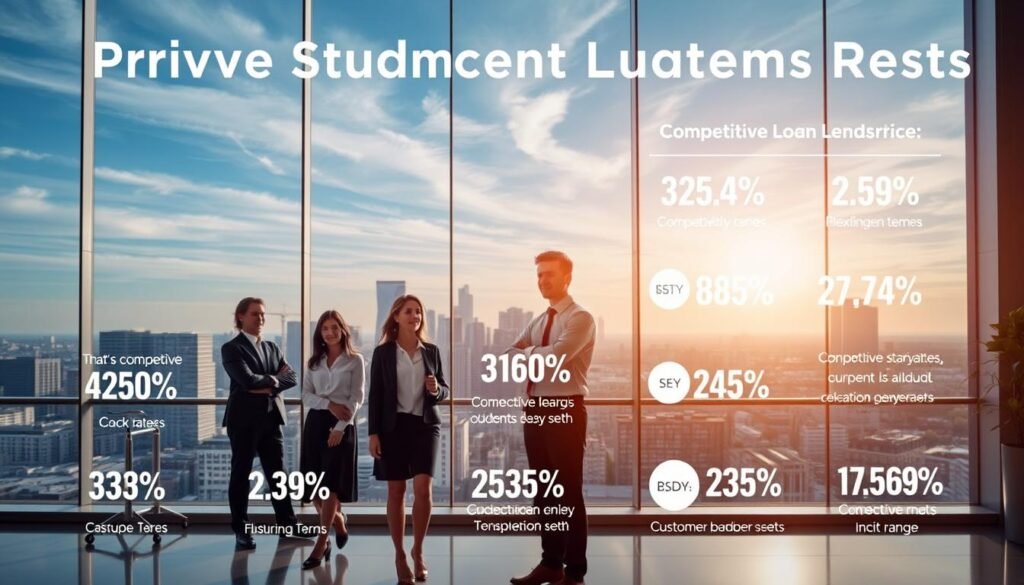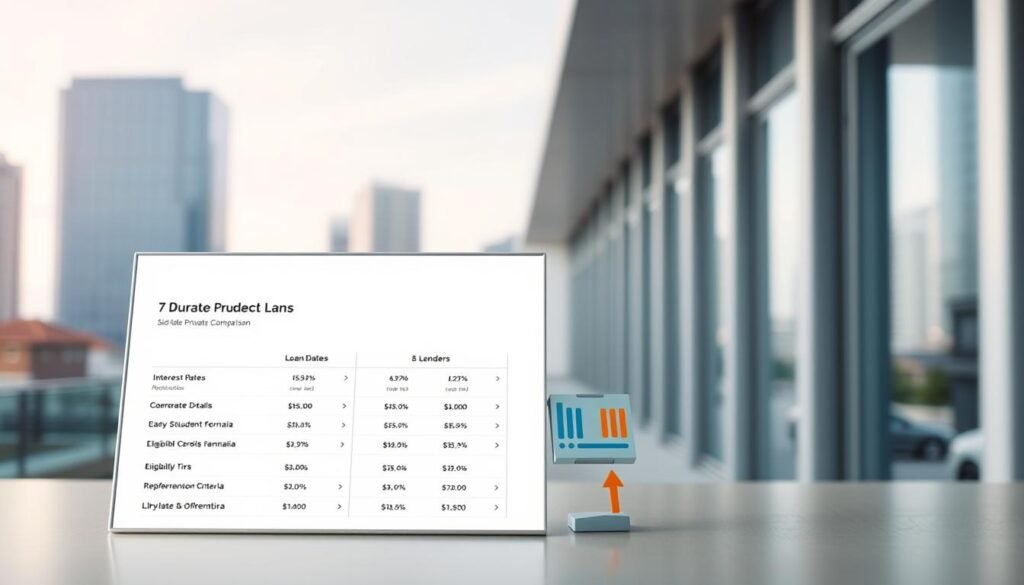
Private Student Loan Lenders with Low Rates: Compare Your Options

Want to know if you can shrink your college costs without risking surprises? You often start here after you review your financial aid package and still face a gap. This guide helps you compare offers and spot what really matters.
First, confirm you’ve maximized grants, scholarships, and federal aid before you consider alternative borrowing. Federal choices usually offer better protections and more flexible repayment than marketplace options.
Use tools like Credible to prequalify and see personalized rates without a hard credit hit. Common names you’ll meet include Sallie Mae, Ascent, College Ave, and ELFI, many of which waive origination fees and offer autopay discounts.
Compare interest rate ranges, repayment terms, cosigner effects, and whether you can borrow up to your certified cost of attendance. Shop and prequalify, then line up offers side by side so you accept the one that fits your budget and timeline.
- Start here: How to use this service directory to compare low-rate private student loans
- Private student loan lenders with low rates
- Fixed rate vs. variable rate: Which interest type fits your budget
- Featured lenders and marketplaces to compare rates and terms
- Credit unions and state-based lenders you can compare
- Repayment options that lower total cost
- Fees, discounts, and terms that impact your monthly payment
- Eligibility factors and the role of a cosigner
- How to apply and compare offers the smart way
- Your next steps to lock in a low rate and the right repayment plan
Start here: How to use this service directory to compare low-rate private student loans
Start by lining up how much you actually need after grants and federal aid, then use that figure to narrow your search. This simple step helps you avoid borrowing more than the certified amount your school allows.
What “low rates” really means right now
Low is relative: published APR ranges vary widely. College Ave, Sallie Mae, and Ascent show fixed and variable spreads that depend on credit, term, and discounts such as 0.25% for autopay.

How to shortlist lenders by degree, school, and credit
- Identify the exact amount you need after COA minus aid so you only compare offers that cover that balance.
- Use marketplaces like Credible to prequalify and see multiple prequalified offers without a hard credit pull.
- Match repayment options interest‑only, fixed in‑school, or deferred to your cash flow to judge total cost, not just advertised APR.
- Check eligibility basics: school participation, enrollment status, residency, and whether a cosigner can help your credit profile.
- Note fees, term flexibility (5–20 years common), and discount rules; a 0.25% autopay cut often applies.
When you're ready, use the directory entries to track each offer's rate type, repayment plan, fees, and discount eligibility. For consolidated comparison tools and more information, visit our comparison hub.
Private student loan lenders with low rates
Look at published APR ranges from major firms to spot which products include autopay discounts and fee waivers.
Top national options list competitive fixed and variable ranges and often waive origination or prepayment fees. Sallie Mae posts fixed APRs from 2.89%–17.49% and variable from 4.37%–16.99%, plus a 0.25% autopay discount and in-school repayment choices.
College Ave shows fixed 2.89%–14.49% and variable 4.24%–14.49% (auto‑pay applied), with terms from 5–15 years. Ascent offers cosigned and non‑cosigned options, fixed around 2.89%–14.41% and variable 4.34%–14.75%, and a 1% cash back graduation reward.
ELFI lists fixed 2.99%–14.22% and variable 5.00%–13.97%, plus dedicated advisors and no fees. Use Credible to see prequalified offers across multiple firms without a hard credit pull.

| Lender | Fixed APR | Variable APR | Key perks |
|---|---|---|---|
| Sallie Mae | 2.89%–17.49% | 4.37%–16.99% | 0.25% autopay, up to 100% COA, no fees |
| College Ave | 2.89%–14.49% | 4.24%–14.49% | Fast decisions, flexible terms, no origination fee |
| Ascent | 2.89%–14.41% | 4.34%–14.75% | Cosigned options, 1% grad cash back, autopay discount |
| ELFI | 2.99%–14.22% | 5.00%–13.97% | No fees, advisors, 5–15 year terms |
Where to find rates shown: always check each lender’s product page and disclosures. Shown include discount requirements and eligibility rules that affect the APR you’ll see. Keep saved links so you can confirm any changes before you apply.
Fixed rate vs. variable rate: Which interest type fits your budget
Pick the interest type based on whether you value certainty in monthly bills or the chance to save if market rates fall.

Predictable monthly payment with fixed rate
Fixed rate stays the same for the life of the loan. That means your monthly payment is stable and easy to plan for.
If you prefer certainty, a fixed option protects you from market swings and payment shock. It also helps if you expect steady income rather than rapid growth.
When a variable rate could save money and when it might not
Variable rates often start lower than fixed offers because they track indexes like the 30‑day SOFR. That can cut interest early on.
But variable interest can rise. If you add accrued interest to principal during in‑school deferment, rising rates amplify total cost.
- Choose fixed for steady payments and budget certainty.
- Pick variable if you can repay fast and tolerate possible increases.
- Check lender disclosures for caps, index, and margin that set future rate moves.
- Use calculators to compare total interest, payment amounts, and repayment timelines under both types.
Featured lenders and marketplaces to compare rates and terms
Compare marketplaces and major providers side‑by‑side so you can judge real costs, discounts, and approval timelines before you apply.
Credible marketplace
What it does: shows prequalified offers from multiple firms so checking rates won’t impact your credit score.
Terms run roughly 5–20 years and many offers list no fees in the marketplace. Use Credible to narrow choices, then inspect each offer’s repayment options and discount rules before you proceed.
Sallie Mae
Highlights: borrow up to 100% of your school‑certified costs, choose interest‑only, $25 fixed, or deferred in‑school plans, and earn a 0.25% autopay discount.
Sallie Mae posts fixed APR ranges from 2.89%–17.49% and variable from 4.37%–16.99% and does not charge origination or prepayment fees.
Ascent
Why consider it: non‑cosigned options plus cosigned products, strong autopay discounts (0.25%–1.00%), and a 1% cash back reward at graduation.
Terms extend up to 20 years, and the platform offers tools to track payments and balances.
College Ave
Key perks: fast credit decisioning, four repayment choices, and flexible terms across undergrad, grad, and parent loans.
Fixed ranges show 2.89%–14.49% while variable offers assume autopay discounts and quick application processing.
ELFI
Standouts: competitive fixed and variable APRs, no application/origination/prepayment fees, and a dedicated advisor to guide your application and acceptance process.
Quick checklist:
- Confirm what the rates shown include most assume autopay or a specific repayment selection.
- Note any available rate reduction or discount and whether it applies during active repayment.
- If you need a cosigner, check policies, release timelines, and how a cosigner affects the credit decision and APR.
- Keep a compact comparison grid of APR, terms, repayment options, and discounts to pick the best overall value.
| Platform | Typical APR Range (fixed) | Term Options | Top perks |
|---|---|---|---|
| Credible (marketplace) | Varies by lender | 5–20 years | Prequalified offers, no hard pull |
| Sallie Mae | 2.89%–17.49% | In‑school to 20 years | Up to 100% COA, 0.25% autopay |
| Ascent | 2.89%–14.75% | Up to 20 years | Non‑cosigned options, 1% grad cash back |
| College Ave | 2.89%–14.49% | 5–15 years | Fast credit decision, 4 repayment options |
| ELFI | 2.99%–14.22% | 5–15 years | No fees, dedicated advisor |
Credit unions and state-based lenders you can compare
Many borrowers find competitive pricing and hands-on support at local credit unions. These groups often publish clear APRs and borrower-friendly terms that merit a close look.
Why consider them: a credit union can offer member-focused service, simpler disclosures, and competitive rates on a loan.
Check membership rules some require employment, family ties, or regional residence. Ask about autopay discounts and whether there are origination or prepayment fees.
State agencies: MEFA, RISLA, CHESLA, and others
State programs often target residents or attendees of in-state schools. They may publish fixed APRs, transparent terms, and no-fee options.
Verify school participation, residency limits, cosigner policies, and hardship support before you apply.
- Confirm eligibility early so you don’t waste applications.
- Compare published APRs, fees, and servicing practices.
- Ask about cosigner release, deferment, and customer support.
| Provider | Typical APR | Key perks |
|---|---|---|
| Credit Union Student Choice | Competitive fixed/variable | Member service, possible autopay discount, limited fees |
| Navy Federal Credit Union | Competitive fixed | Strong member benefits, cosigner options, clear disclosures |
| State agencies (MEFA, RISLA, CHESLA) | Attractive fixed programs | Resident/school eligibility, no origination fees, borrower support |
Repayment options that lower total cost
Small in-school payments can make a big difference to what you owe years from now. Choosing how you handle payments while enrolled affects whether unpaid interest is added to your balance.
Interest-only vs. $25 fixed vs. full deferral
Interest-only means you pay interest as it accrues so the principal does not grow. That reduces total interest over the term and can cut lifetime cost Sallie Mae examples show freshmen may save about 17% versus deferred plans.
$25 fixed keeps you making steady progress. It won’t cover all interest, but it limits how much capitalizes and can lower total cost by roughly 7% in examples versus full deferral.
Full deferral pauses payments while you attend school and during grace. Any unpaid interest is added to principal, which increases future monthly payments and total interest paid.
Practical tips to reduce total cost
- Even small interest payments now reduce principal interest that capitalizes later.
- If cash is tight, start with $25 fixed and add extra when you can.
- Set up autopay to avoid missed payments and capture a common 0.25% discount.
- Use your lender’s calculator to model scenarios and pick the repayment path that fits your budget and long-term goals.
Fees, discounts, and terms that impact your monthly payment
Start by mapping fees and discounts side-by-side so you can see how each choice affects your monthly bill.
Favor offers that charge no origination or prepayment fees. That means more of your payment goes to principal and less to upfront or exit costs.
Enroll in auto debit to capture a common 0.25% interest rate reduction. That small cut lowers monthly payments and total interest over time.
- Verify whether a discount applies only during active repayment or if it pauses in deferment or forbearance.
- Understand cosigner release rules qualifying income, credit, and on‑time history matter (some programs allow release after 12 months).
- Compare standard terms (5, 7, 10, 12, 15, 20 years) to balance payment size and lifetime interest.
Read how payments are applied: fees first, then interest, then principal. Extra money cuts principal and shortens your term.
| Feature | Why it matters | What to check |
|---|---|---|
| No origination/prepay fee | Saves upfront and exit cost | Confirm fee policy in disclosures |
| Auto debit discount | Reduces APR and monthly payment | Is discount active during deferment? |
| Cosigner release | Lets you remove a cosigner later | Required history, income, and credit thresholds |
Document fees, discounts, and terms in your comparison sheet so you see true monthly and lifetime costs before you apply.
Eligibility factors and the role of a cosigner
When you apply, underwriters look for clear signals that you can repay. Your credit score, repayment history, and debt-to-income ratio form the core of every credit decision. Lenders also verify enrollment at an accredited school and check citizenship or residency rules.
A strong profile raises approval odds and may lower your rate and interest cost. If you lack credit history or steady income, a cosigner often fills that gap and improves the offer.
Credit decision basics: score, history, debt-to-income
Your score and payment record drive the APR you see. Lenders review outstanding balances, recent delinquencies, and whether you have steady income to cover payments.
Reducing card balances and avoiding new hard inquiries before you apply can help. Keep ID, Social Security (if applicable), and school details ready for verification.
Why many undergrad applications are cosigned and how it affects the outcome
Most undergrad applications are cosigned because students often lack credit or income. Some firms report over 90% of undergrad requests include a cosigner.
A qualified cosigner can multiply approval chances several times and may secure a better APR. Remember: the cosigner shares legal responsibility and their credit is affected by missed payments.
- Ask about cosigner release rules and required on-time history.
- If you belong to a credit union, explore member advantages that might improve underwriting.
- Confirm minimum score thresholds and income requirements before applying.
| Eligibility item | What lenders review | How it affects the offer |
|---|---|---|
| Credit score & history | FICO/Vantage, delinquencies, payment patterns | Directly influences APR and approval |
| Debt-to-income (DTI) | Monthly obligations versus income | Higher DTI can raise APR or trigger cosigner need |
| Enrollment & residency | School certification, citizenship or permanent residency | Required for eligibility; missing items delay disbursement |
| Cosigner profile | Income, score, history | Improves approval odds; may lower APR |
How to apply and compare offers the smart way
Work from a clear dollar target: cost of attendance minus grants and federal aid equals the amount to request. That single number keeps applications honest and avoids borrowing extra.
Prequalify first. Use marketplaces to preview APR, fees, and terms without a hard credit hit. Then apply to 3–5 issuers to boost approval odds and find better repayment options.
After approval, your chosen firm sends the requested amount to your certified school. Expect certification and disbursement to take about 10 business days from final approval.
- Confirm your school will certify the amount and that the provider participates in your program.
- Compare offers side by side: APR, fees, term length, repayment options, and discounts like autopay.
- Track tuition deadlines so disbursement timing won’t delay enrollment.
Leftover funds: if tuition is covered, schools typically release remaining funds to you for eligible expenses. Keep all disclosure documents; they show how interest accrues and how payments are applied.
| Step | What to check | Typical timing |
|---|---|---|
| Calculate amount | COA minus grants & federal aid | Immediate |
| Prequalify | Preview APR and terms without hard inquiry | Same day |
| Apply & certify | School certifies requested amount | Up to 10 business days |
| Disbursement & leftover | Funds sent to school; excess released per school policy | Within about 10 business days |
Your next steps to lock in a low rate and the right repayment plan
Map a short action plan this week: prequalify at Credible or check offers from Sallie Mae, Ascent, College Ave, and ELFI, then save the best entries for a side‑by‑side review.
Decide fixed or variable rate by modeling the monthly payment and total cost under each scenario. Compare repayment options, confirm any interest rate reduction or autopay discount, and note the fees and term choices before you apply.
When possible, make interest payments while you attend school. Small interest payments now reduce principal interest later and shrink principal interest payments after graduation.
Line up a strong cosigner if needed, verify cosigner release rules, and check your school’s certification timeline so funds disburse on time each term. Also consider a local credit union or state program for competitive, borrower‑friendly options.
If you want to know other articles similar to Private Student Loan Lenders with Low Rates: Compare Your Options you can visit the category Loans.






Leave a Reply